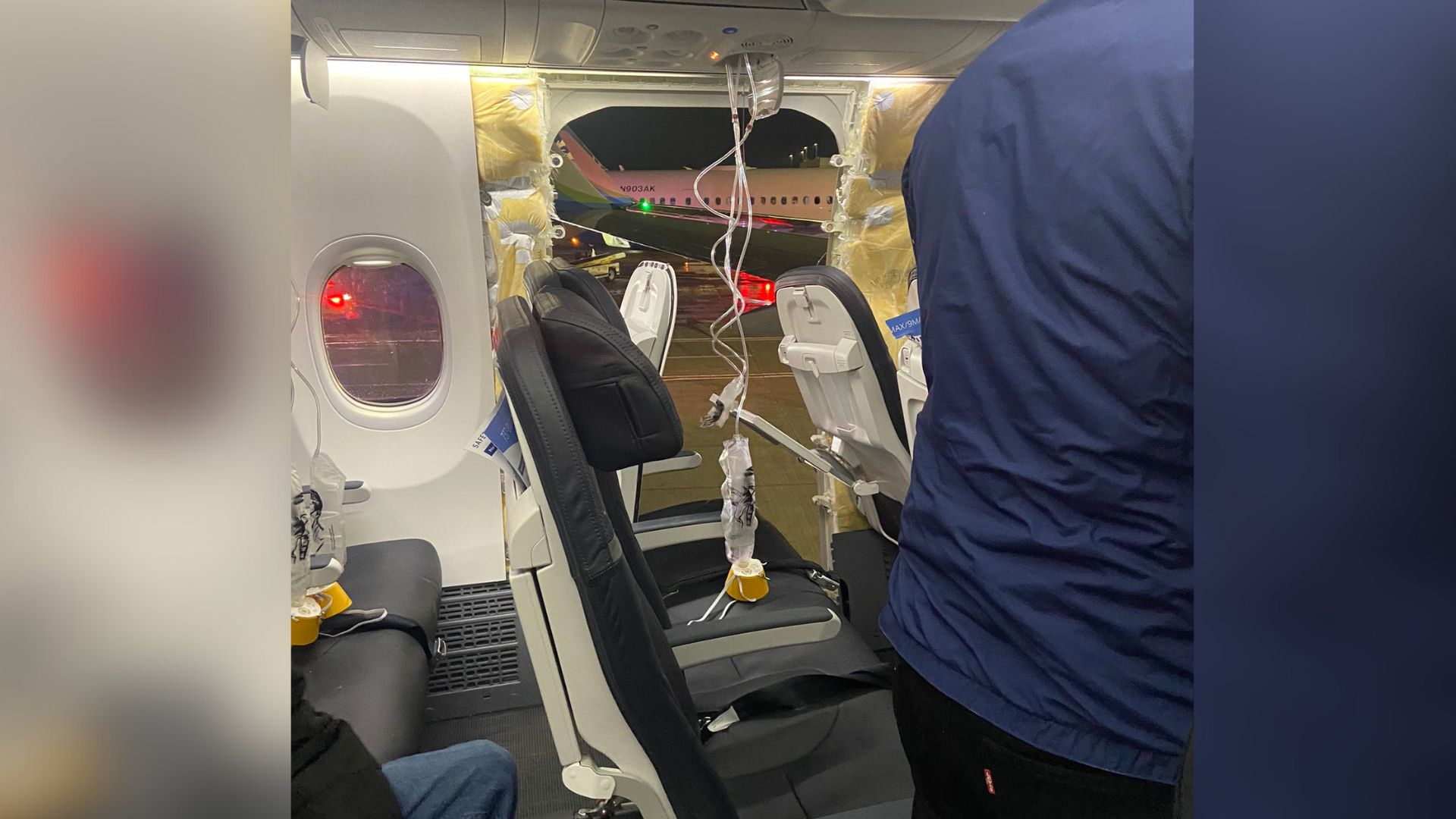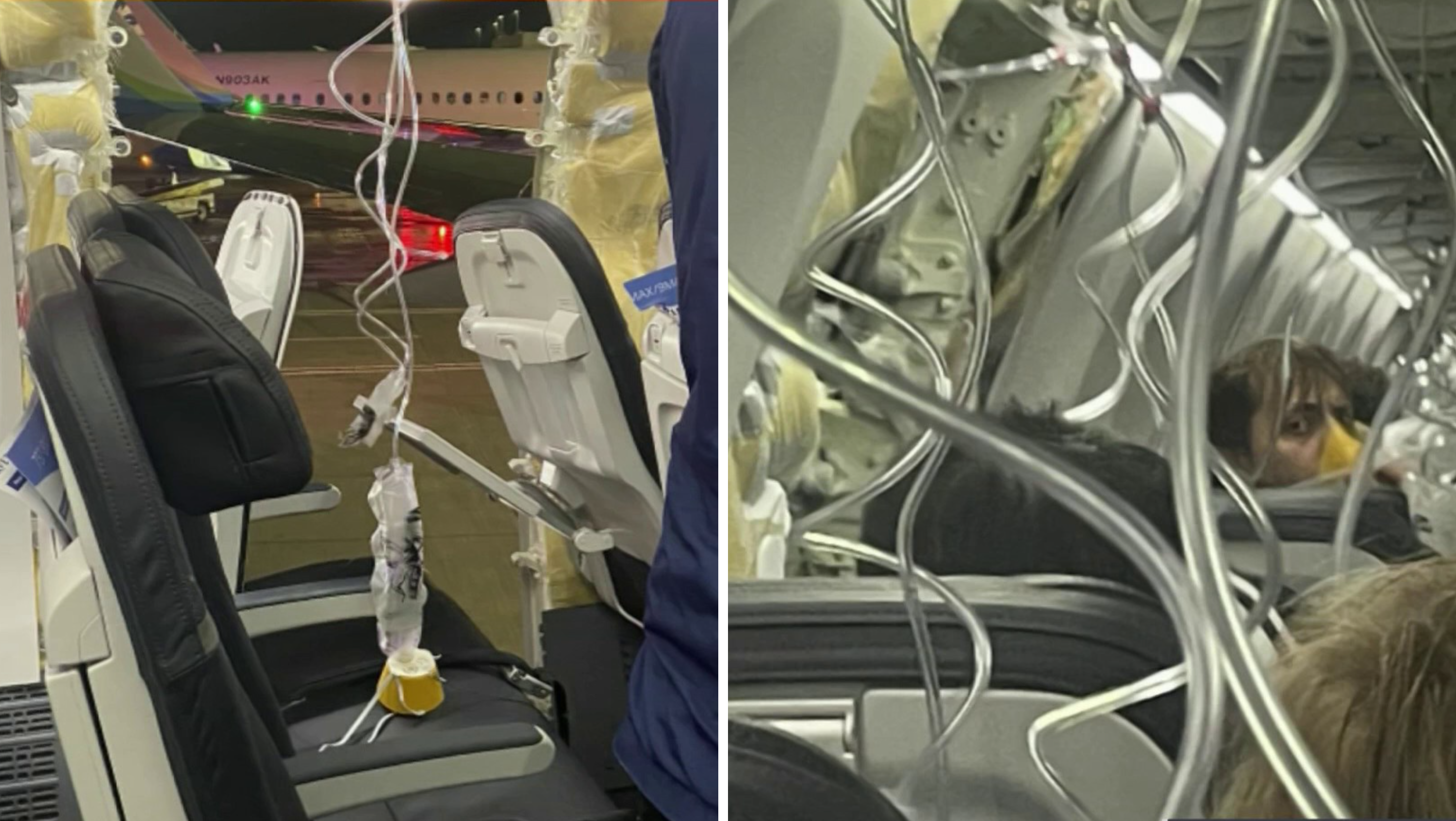Inspections and a federal investigation are underway after a door plug detached in-flight on an Alaska Airlines plane bound for Southern California.
The blowout, shortly after takeoff Friday night from Portland, led to the grounding of dozens of Boeing 737 Max 9 planes with the same configuration as the plane bound for Ontario International Airport.
No serious injuries were reported when the door plug, a panel in the plane fuselage where a door could be installed depending on how an airline configures the plane, detached over Oregon on Alaska Airlines Flight 1282. The door plug was found in a backyard near Portland, authorities announced Sunday, and could help investigators determine what went wrong.
Get top local stories in Southern California delivered to you every morning. Sign up for NBC LA's News Headlines newsletter.
The aircraft landed safely back at the airport in Portland.
Here's what to know about the blowout, the plane and what happens next.
Boeing 737 Max 9 inspections find loose bolts
The Federal Aviation Administration ordered the grounding of some Boeing Max 9 operated by U.S. airlines or flown into the country by foreign carriers until they are inspected. The emergency order affects about 171 planes worldwide.
On Monday, Aviation publication The Air Current first reported that United had discovered loose bolts during inspections. United has 79 of the Max 9 passenger planes in its fleet.
“Since we began preliminary inspections on Saturday, we have found instances that appear to relate to installation issues in the door plug — for example, bolts that needed additional tightening,” Chicago-based United said.
Alaska said that as it began examining its Max 9s, “Initial reports from our technicians indicate some loose hardware was visible on some aircraft.”
NTSB examines door plug retrieved from Portland-area backyard
The NTSB has begun an investigation that is likely to last months and focus on the paneled-over exit door that blew off. The so-called door plug is installed on some jets that have fewer seats instead of an emergency exit panel. The jets ordered grounded by the FAA all have those panels installed.
Investigators said Sunday they had found the door plug in backyard near Portland and hoped it would provide physical evidence of what went wrong. Investigators also are looking at scratch marks on the metal frame that could help tell them what happened.
The door panel appeared to have slid up before detaching from the jetliner, federal investigators said Monday. They are looking into whether four bolts designed to hold the panel in place might have been missing when the plane took off from Portland.
What is a door plug?
Some larger Boeing 737s have emergency exits on fuselages behind the wings to meet a federal requirement that planes be designed so passengers can evacuate within 90 seconds even if half the exits are blocked.
The more passenger seats there are on a plane, the more exits are required.
Some carriers, including Indonesia's Lion Air and Corendon Dutch Airlines, cram more than 200 seats into their Max 9s, so they must have extra emergency exits. However, Alaska Airlines and United Airlines configure their 737 Max 9s to have fewer than 180 seats, so the planes don't need the two mid-cabin exits to comply with U.S. evacuation rules.
On Alaska and United, the only two U.S. airlines using the Max 9, those side exits near the back of the plane are replaced with a permanent plug the size of an exit door.
The NTSB shared photos of the door plug Monday. It will be sent to Washington D.C. for testing.
What happened after takeoff on Alaska Airlines Flight 1282?
The portion of fuselage on Flight 1282 detached seven minutes after takeoff and about 3 miles above Oregon Friday night. A rapid loss of cabin pressure caused oxygen masks to drop from the ceiling.
Video from inside the plane showed a gaping hole, about the size of a refrigerator, where the door plug detached.
National Transportation Safety Board Chair Jennifer Homendy said the two seats next to the part that tore off were unoccupied.
Passengers aboard the flight Friday described a loud "bang" or "pop" sound when the door plug detached.
"I looked to my left and there's this huge chunk of the airplane missing," said passenger Elizabeth Lee. "Part of the airplane is missing, and the wind just was extremely loud. There's wind blowing everywhere."
Stan Sigstad said he heard a loud 'pop' sound and felt the push and pull of the wind through the hole in the fuselage.
"I felt it hit me in the face," Sigstad said. "I was trying to make sense of what's going on."
How are airlines responding?
Alaska Airlines canceled 170 flights across the country Sunday. The airline said the cancellations affected about 25,000 customers
More cancellations were expected through the first half of the week.
Early Monday, 20% of the carrier's flights were cancelled, 139 in all, according to the flight tracking site FlightAware.
Passengers whose flights are canceled will be moved the next available flight, the airline said. They also can request a change or a refund without incurring fees under a flexible travel policy.
United Airlines also suspended service on its Boeing 737 Max 9 planes pending inspections.
Lauren Alba, director of executive communications for Los Angeles World Airports, which operates LAX, told City News Service that five Alaska Airlines flights and eight United flights were affected Sunday, but she added that the airport was seeing no major impacts from the order.
Spokesman Mike Christensen of Hollywood/Burbank Airport told City News Service that the airport had seen no cancellations or delays as of Sunday morning.
Alaska Airlines CEO Ben Minicucci apologized to the passengers aboard the Ontario-bound flight.
"My heart goes out to those who were on this flight," Minicucci said. "I am so sorry for what you experienced. I am so grateful for the response of our pilots and flight attendants. We have teams on the ground in Portland assisting passengers and are working to support guests who are traveling in the days ahead."
How many planes are grounded?
The Federal Aviation Administration grounded about 171 Boeing 737 Max 9 planes Saturday. Alaska Airlines had grounded all its 737 Max 9 planes Friday pending inspections, with plans to resume flights once the planes were deemed safe.
The FAA estimated that the inspections would take between four and eight hours per aircraft.
United Airlines, the world’s biggest operator of Max 9s, grounded its entire fleet of 79 Max 9s and is seeking to “clarify the inspection process and requirements for returning” them to service. The airline had cancelled 204 flights early Monday, or 7% of all planned departures, according to FlightAware.
Alaska and United are the only two U.S. passenger airlines that operate Max 9 aircraft. The companies operate nearly two-thirds of the 215 Max 9 aircraft in service around the world, according to aviation analytics firm Cirium. Six other airlines use the Max 9: Panama's Copa Airlines, Aeromexico, Turkish airlines, Icelandair, flydubai, and SCAT Airlines in Kazakhstan, according to Cirium.
What happened to the cockpit voice recording?
The Alaska Airlines plane's cockpit voice recorder won't be part of the investigation. The portion recorded during the blowout was inadvertently recorded over, the NTSB said.
"That is unfortunately a loss for us," National Transportation Safety Board Chair Jennifer Homendy said Sunday. "Because that information is key, not just for our investigation, but for improving aviation safety."
Homendy said the agency is calling for expanding the minimum amount of time recorded on cockpit voice recorders from two hours to 25 hours. The device aboard the plane automatically recorded over voice data from the blowout because it was not powered down, Homendy said, explaining that the device starts a new recording every two hours and wipes out the previous recording.
About the Boeing 737 Max 9
The incident has also renewed questions about the safety of Boeing's Max aircraft, which the newest version of the company's storied 737. There are two versions of the aircraft in service: the Max 8 and the Max 9, which is the larger of the two.
Regulators around the world grounded Max 8 planes for nearly two years after a Lion Air flight crashed in Indonesia in 2018, and an Ethiopian Airlines Max 8 crashed in 2019. Boeing changed an automated flight control system implicated in the crashes.
Last year, the FAA told pilots to limit use of an anti-ice system on the Max in dry conditions because of concern that inlets around the engines could overheat and break away, possibly striking the plane. And in December, Boeing told airlines to inspect the planes for a possible loose bolt in the rudder-control system.
However, those past issues are unrelated to Friday's blowout, which is an exceedingly rare event in air travel.
Anthony Brickhouse, a professor of aerospace safety at Embry-Riddle Aeronautical University, said it's too soon to say whether the blowout involved an issue with Max 9s or that specific flight. Brickhouse said passengers should feel confident that regulators and airlines will make sure the grounded Max 9s are safe before returning them to service.
Brickhouse said it it was lucky that the emergency occurred shortly after takeoff when passengers were all seated with their seatbelts on. But he said that doesn't mean passengers should feel scared to leave their seats once the pilot turns off the “fasten seatbelt” sign because it's so unlikely for holes to open in the fuselages of airliners.
In 1988, a flight attendant for Aloha Airlines was blown out of the cabin of a Boeing 737 over the Pacific Ocean after an 18-foot-long chunk of the roof peeled away. Metal fatigue was blamed in that case, which led to tougher rules for airlines to inspect and repair microscopic fuselage cracks.
“When passengers board a flight they should feel confident that the aircraft they are flying on is safe,” Brickhouse said.
In 2018, a passenger on a Southwest Airlines jet was killed in when a piece of engine housing blew off and shattered the window she was sitting next to. That incident involved an earlier version of the Boeing 737, not a Max.
"Safety is our top priority and we deeply regret the impact this event has had on our customers and their passengers," Boeing said in a statement. "We agree with and fully support the FAA's decision to require immediate inspections of 737-9 airplanes with the same configuration as the affected airplane. In addition, a Boeing technical team is supporting the NTSB's investigation into (Friday's) event. We will remain in close contact with our regulator and customers."




